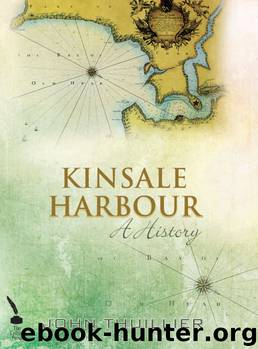Kinsale Harbour by John Thuillier

Author:John Thuillier [Thuillier, John R.]
Language: eng
Format: epub
ISBN: 9781848898486
Publisher: The Collins Press
Published: 2014-06-22T16:00:00+00:00
The Devil’s (left) and Charles (right) bastions at Charles Fort. Courtesy Irish Examiner
Eventually it was decided that the defence of the harbour would centre on the building of a ‘showpiece citadel’. The project had been sanctioned by Charles II in 1667 on the site at Rincurran, provided by Robert Southwell, where the ruins of the Barry Óg Castle were still visible. It was described, prematurely as it turned out, as the ideal location where ‘all objects are visible seaward from their appearance on the horizon’. The Fort, designed by William Robinson, is recognised as a fine example of a pentagon-shaped bastioned structure. Many of the features were borrowed from de Vauben who, as fortifications expert to Louis XIV, influenced military building throughout Europe. Locations as far apart as the walls around the city of Lucca in Tuscany and the blockhouse at Camaret-sur-Mer in northwest Brittany, both having trade links to Kinsale, had defensive features similar to the new fort which was substantially complete in 1681 and named Charles Fort by Lord Deputy Ormond.
The major features of the Fort are its five bastions. The ‘Kinsale’, now known as the ‘Devil’s’, and the ‘Charles’ are substantial, as attack was expected to come from the seaward side. Both are large bombproof casemated structures designed to accommodate a second level of cannon. The other three bastions – the ‘Cockpit’, the ‘Flagstaff’ and the ‘North’ – face towards the land. Between these are the curtain walls broken with externally splayed gun embrasures. Placed at these openings were eleven large cannon, capable of firing 24 lb balls, on sloping limestone mountings at a gradient designed to absorb the recoil. Various other ordnance and powder, stored in the explosion-proof magazine, provided the defence against ships entering the harbour that ‘must sail within a pistol distance’.37
The Fort, towering over the mouth of the harbour, was a deterrent to any enemy approaching from the sea. However, the high ground to the north and east made the Fort vulnerable if attacked from the land. Defence was also weakened by the tower and the church of the ancient Teampall an Trionóide located at a point overlooking the new Fort. Because of its proximity it was demolished and relocated to Ardbrack, leaving only the well and the burial ground, which are still in use, at the Fort Hill.
Apart from its imposing defence features towards the sea, the choice of location at Rincurran was poor and difficult to justify when previous history is considered. The earlier Barry Óg Castle on the same site was taken by George Carew, the second in command on the English side during the Siege of Kinsale prior to the Battle in 1601. The account shows how exposed the site was to the surrounding high ground. Using the height and setting the angle of the cannon to the correct inclination, Carew overcame the stout resistance of the Spaniards inside: ‘He did score out his ground markers and with his quadrant took the true level so as the want of light was no hindrance.
Download
This site does not store any files on its server. We only index and link to content provided by other sites. Please contact the content providers to delete copyright contents if any and email us, we'll remove relevant links or contents immediately.
| Automotive | Engineering |
| Transportation |
Small Unmanned Fixed-wing Aircraft Design by Andrew J. Keane Andras Sobester James P. Scanlan & András Sóbester & James P. Scanlan(32763)
Navigation and Map Reading by K Andrew(5132)
Endurance: Shackleton's Incredible Voyage by Alfred Lansing(4715)
And the Band Played On by Randy Shilts(2163)
The Box by Marc Levinson(1964)
Top 10 Prague (EYEWITNESS TOP 10 TRAVEL GUIDES) by DK(1956)
Wild Ride by Adam Lashinsky(1950)
The Race for Hitler's X-Planes: Britain's 1945 Mission to Capture Secret Luftwaffe Technology by John Christopher(1836)
The One Percenter Encyclopedia by Bill Hayes(1811)
Trans-Siberian Railway by Lonely Planet(1725)
Girls Auto Clinic Glove Box Guide by Patrice Banks(1706)
Bligh by Rob Mundle(1675)
Looking for a Ship by John McPhee(1651)
Good with Words by Patrick Barry(1639)
Batavia's Graveyard by Mike Dash(1632)
TWA 800 by Jack Cashill(1625)
Fighting Hitler's Jets: The Extraordinary Story of the American Airmen Who Beat the Luftwaffe and Defeated Nazi Germany by Robert F. Dorr(1610)
Troubleshooting and Repair of Diesel Engines by Paul Dempsey(1577)
Ticket to Ride by Tom Chesshyre(1566)
